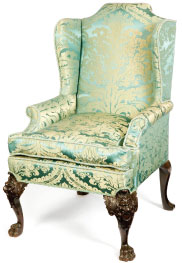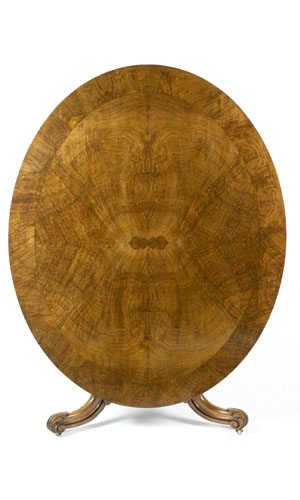Walnut is a highly figured wood that has a nutty brown colour. It was used in its solid form in furniture from about 1660s to 1690s and thereafter in a veneered form up until 1735. Walnut continued to be used throughout the early part of the 18th century but had taken a decline in its fashionable status in the late part of the 18th century but remerged in the Victorian period where it grew in prominence. Prior to walnut, oak was seen as the preferred wood of furniture makers but with the British Empire growing, its taste for foreign woods was also beginning to grow.
With walnut a significant change in both the style and construction had begun. New techniques of how to use such woods in designing had begun to emerge. During the reign of George I there was a lot of furniture made from walnut. A dominant feature of the walnut and why it was so popular was its natural figure and its serpentine line. The veneering is originally thought to have come from Holland from about 1660s. Walnut was grown in Britain but was not of the same quality to that which was imported. The English walnut was similar to mahogany but with the length of time that it had taken to grow and with the increasing demand throughout the British Empire it was insufficient to meet the needs demand of the market. Walnut grew better in warmer climates such as those in mainland Europe where it was at its best quality, hence the importation of walnut on a large scale.
Like many trends and fashions of the time and still to the present day, walnut had been a statement to others, both in design and as a show of wealth. Two reasons for the introduction of mahogany to England were, France were one of the main suppliers of walnut to Britain, but had prohibited its exports to England. In order to remedy the lack of raw material for naval construction the government in London abolished the heavy taxes that had been imposed on all timbers brought in from The AMERICAS. In respect to the Irish Aristocracy they began to import pieces of walnut furniture from Britain as it was fashionable to do so plus it was seen as more desirable and extic than the Irish oak furniture. The period most popular for walnut furniture was during the reign of Queen Ann, the furniture’s with it unassuming grace was in keeping with the design and ambience of the age.
Further to this, the beautiful pattern of the burr walnut with its curves improved craftsmanship and the construction of furniture. However as time progressed new timbers such as mahogany was seen as more durable for naval use and also by cabinetmakers. They favoured it for many reasons such as its grain as it was easier to work with; also the finished piece looked well, coupled with the size and abundance of mahogany proving better for the British and Irish damp conditions. Gone were the days of the Baroque taste which was seen by some as being vulgar and a more structured manner in design was desired. As you will see there are many pieces in both our Dublin and New York stores made from solid or veneered walnut.

